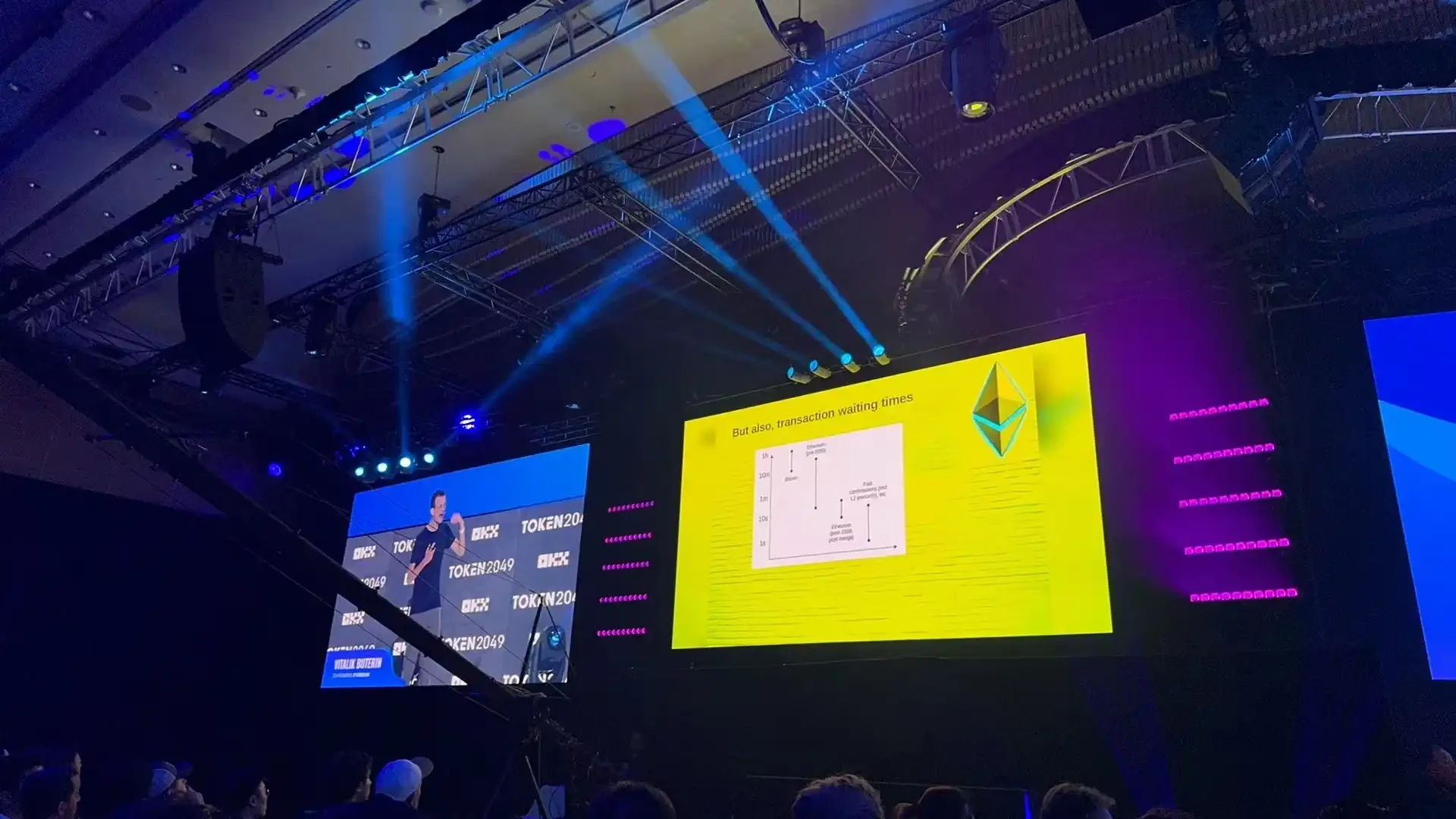Ethereum co-founder Vitalik Buterin delivered a keynote speech titled What Excites Me About the Next Decade when participating in TOKEN 2049. He believes that the current crypto industry is no longer in its early stages, but it is still in its early stages in terms of practical usability and Ethereum needs to meet the needs of mainstream adoption . The following is the original text of Vitaliks speech, which has been compiled and simplified by Odaily Planet Daily. Enjoy~

It’s no longer early days for the crypto industry
A lot of times when people talk to me about some of the challenges we’re facing right now, they tend to say, “You know, it’s still early days, we’re still building out the basic infrastructure, look how long it took the internet to get off the ground.” People have been saying this since Bitcoin launched, but I think now is the time to focus on the product, crypto is no longer in the early stages.
Bitcoin has been around for 15 years, Ethereum has been around for over 10. We’ve seen things like ChatGPT go from being completely non-existent to suddenly taking off and completely changing everyone’s understanding of AI.
So we have to ask ourselves the question, how should we view all of this? I think the answer to that question is that we are not in the early days of crypto, but we are certainly early in terms of crypto being “actually usable.” So let me explain what I mean by looking back at some history.
I remember back in 2013, our team, we were all excited about Bitcoin and thought it was the next big revolution in payments, and the builders made a very amazing and serious effort to try to get regular merchants around the world to start accepting Bitcoin. Who remembers Room 77 in Berlin? There was a restaurant there that accepted Bitcoin payments, and it was actually the first Bitcoin restaurant I went to. In 2013, you could proudly say that you were a restaurant that accepted Bitcoin, and people were very excited about it.
So what happened next? Let’s go a little deeper, I remember when I first traveled to Argentina in 2021, the first thing I noticed was that people across the country were not only very excited about cryptocurrency, but they were actively using it on a large scale.
I was walking around one Christmas and I went into a coffee shop that was open and the owner knew who I was and allowed me to pay with crypto. They were able to use crypto but they were not actively using decentralized technology.
What technology were they using? It turns out that the locals in Argentina were using financial transfers. Because financial transfers are instant and free. I think its the same issue in the end - fees, at least it killed the cryptocurrency wave: get everyone to accept Bitcoin as a currency.
If you remember the marketing of cryptocurrency in the beginning, it talked a lot about fees for Western Union, Paypal, credit cards, and they charged customers very high fees. But then the fees for Bitcoin itself went up to $50.
And fees on Ethereum are going up, the highest fees I pay on Ethereum are actually for privacy service transactions. But theres no denying that gas prices have gone up, and every time I do an operation, theres a lot of comments on Twitter. So privacy protocols have a very good product market fit, but some transactions cost about $800. So fees are expensive, which is basically why a lot of things fail.
Ethereum gets faster and cheaper
So, what’s new in 2024? Here’s a chart of Ethereum fees, and they’ve gone from between 10 and 50 cents to under 1 cent and essentially zero at the same time. Meanwhile, Optimism and Arbitrum, two of the main Ethereum Laeyr 2 backends, have reached a major security milestone called Phase 1, and multiple ZK-based Rollups have told me that they plan to reach Phase 1 soon. So Rollups will soon get more secure, too.

The issue of cost has actually been resolved, but that is not the only important thing.
Another annoyance I remember vividly while traveling in Argentina was when I tried to transfer money to someone using the Ethereum mainnet, and the transaction fee was about $4, and the transaction took about 5 minutes to confirm. Although EIP-1559 was already online at this time, the wallet I was using at the time had not actually been upgraded.
Bitcoin blocks are generated every 10 minutes. So you have to wait 10 minutes, or even an hour, for your transaction to be confirmed. Theoretically, Ethereum has a block confirmation time of 13 seconds, but due to gas, the market can be inefficient and sometimes you have to wait for completely random block confirmation times, which could be 5 minutes or even longer for your transaction to be included.
But EIP-1559 actually basically solves that problem. If you add the merge function, one of the things that the merge function does is it cuts the average wait time for the next transaction in half.
With the above two upgrades, we now have transaction confirmation times within 5 to 15 seconds. If you use a Layer 2 solution with fast and free confirmations, it can usually be reduced to one second. So basically these two major issues are the biggest factors that lead to centralized user experience being far superior to decentralized user experience in 2021.
Encryption is more than just an efficiency technique
But we can also look at the general user experience quality of the application. If you look at a tweet I posted in 2015, it was about a hackathon, and it mentioned Firefly, which was a client for Farcaster and Twitter and Lens. If you look at the quality of the user interface, it looks like its in line with the quality of a Web2 product, but its a decentralized application.
Weve also seen progress in account abstraction this year. Weve seen more and more people using security protocols. Weve seen EIP-7702. Were starting to see mainstream adoption of ZK-snarks, all kinds of different applications, and we have new and better privacy protocols. Theres also zero-knowledge proofs, where I can prove that this is your knowledge, and you can have a passport and use it to your full potential, and it can even be used for usability improvements between existing Layer 2s.
Two years ago, everyone was complaining about having to manually switch networks. Today, I dont think Ive actually manually switched networks in at least the past year. So the limitations of the technology were a barrier. I even remember that moment when CryptoKitties looked like it might become a real breakout app, but then what happened? The success of CryptoKitties pushed Ethereums gas price up to 50.
Ethereum became essentially unusable, which really limited its growth. Thats no longer the case, which basically means one reason not to use crypto is gone. So whats the reason to use crypto? I think one mistake people make sometimes is talking about crypto SDKs and thinking about crypto as an efficiency technology. Thats something a lot of people were talking about 10 years ago.
What were the benefits of Bitcoin in 2013? Making payments easy, secure control of your funds, zero or lower fees, protecting personal identity, etc. Of these four, two are characteristics that I think are very unique to cryptocurrencies. The other two were once unique to cryptocurrencies, but are they still the case? Today we have Venmo, and some better payment methods, such as WeChat Pay.
Centralized systems are getting better, but in some places, payment and access to finance is still very difficult. Why is it difficult? Its not because of technology, its mainly because of global political constraints. So I think its important to remember that the benefits that cryptocurrencies bring to the world are not tied to the same kind of technological advances. Its the same technological improvement that goes from a regular jet to a supersonic jet. Although they are both airplanes, they are a different type of technology.
So what exactly is this technology? One way to think about it is to refer to this blog post written by Josh Stark at the Ethereum Foundation, published about two years ago. The title of the article is Atoms, Institutions, Blockchains. The argument is that blockchains allow us to create a kind of digital solidity, which allows us to create persistent digital structures that are difficult to change.
These structures are solid and cannot be broken, just like physical structures made of concrete. What is the difference between blockchain and previous web technologies? In the past, if your file sharing network crashed, it didnt matter, you just switched to another network, and in a week, everyone forgot about it. But in the blockchain, if one locking mechanism crashes and you switch to another, everyone loses all their money. This is a fundamental difference.
Blockchain enables the internet to not only compensate for weaknesses in its overall structure, but actually make it better at building alternatives that can solve similar problems.
Blockchain is digital concrete that can be used to build a virtual city in the sky. So has anyone here seen the movie Castle in the Sky?
I think this movie is really great, I think it’s definitely one of Studio Ghibli’s best, and I’ve seen it at least five times. But it turns out that this movie was also, in a way, an accidental inspiration for Ethereum, even though I didn’t realize it myself.
I discovered Ethereum in 2013 while browsing the list of fictional elements on Wikipedia. It was a really great name, and it reminded me of a scientific theory from the 19th century. Two months later, a former portfolio designer at the Ethereum Foundation decided to use the diamond as the Ethereum logo. At the time I thought it was a cool diamond, and I liked the logo, it was beautiful.
Seven years later, when I first saw the movie, I realized they also had Ethereum crystals. Ethereum crystals actually look like diamonds. Ethereum looks like a digital castle in the sky, and I think the serious and fun aspects of cryptocurrency are combined together, and thats what I want people to remember. A castle can protect you, protect your family, protect your community, or it can be a castle in Disneyland, so your community can have fun; a castle can also be a castle in Disneyland, so your community can have fun; a castle can also be a museum that preserves thousands of years of history of your culture. A castle can also be all of these things, and we can build all kinds of digital castles on Ethereum.
Blockchain needs to meet mainstream adoption requirements — wallet security as an example
So, after completing these constructions, we need to meet the needs of mainstream adoption, and at the same time we need to adhere to open source and decentralized values. What does this mean? For example, wallet security.
Historically, there have been basically two ways to keep safe your funds:
The first method is a crazy bit of self-preservationism. You write down a mnemonic phrase, and you do everything offline. You carve the mnemonic phrase into a piece of titanium, and then you put the titanium into a stronger titanium lockbox, and then you bury the lockbox 10 meters underground, and your coins are safe. This is one method.
Another way is that you can give your coins to a trustworthy person. You know this nice guy, his name is Sam. He attends events with Clinton, he must be trustworthy. But two years later, it turns out that you were a little wrong about who is trustworthy and who is not.
I dont think these are the only two options. If you want to protect yourself from centralization, you can do traditional self-custody, such as putting the mnemonic in titanium and burying it 10 meters underground. If you want to have both, what should you do?
This is where multi-signature secure smart wallets come in handy. Multi-signature security means you have multiple keys, for example you may have 6 keys and you need 4 to send a transaction. You can even set a rule that only one key is needed for small transactions. These keys can be any combination you control, including friends and family, etc.
Today, you can actually create a simple real account, which is a smart contract wallet, and you can only send transactions from it if you generate a proof that you control a specific email address. So now you can basically bring the social recovery capabilities of Web2 into the world of Web3. In the world of Web3, you can even diversify your trust.
So you can have a Gmail account zk-wrapped by a US company, and then you can combine that into a CK-wrapped one, and you can also have three keys made by a hardware wallet made by a Chinese company. So you can even get the benefits of institutional-grade trust without a lot of the weaknesses. Forecast is a Web2 app in terms of user experience, but users can set recovery addresses, and in the future it may be possible to control their own accounts through multi-signatures. I personally trust my multi-signature account much more than any centralized account.
Decentralization and practicality
Theres a demo wallet based on Ethereum, but it has the same user experience as Venmo. Theres a mechanism where users can prove that their withdrawals came from some deposits, without revealing which one, but they can prove that their deposits didnt come from bad actors. So its a way for regular users to have very high privacy, which meets a lot of important needs, but theres actually no backdoor.
For example, for ZK social media, a super account could be used. We can prove that you are part of the community, provide proof to people who are having problems or solve reputation problems, while still protecting his privacy. This does not require the user to be present, does not require someone to trust you or require KYC to verify you. We can have privacy and trust at the same time.
On the Ethereum mainnet, many technical improvements are happening to make Layer 1 more decentralized and easier to verify while reducing final confirmation time and increasing capacity. These things are already happening. These are the directions that the Ethereum ecosystem and I think cryptocurrency will develop in the next 10 years.
Now we have basically two bad paths, one is to sacrifice utility for decentralization and forever become an ecosystem that only appeals to itself. It only has 695 users. The other bad path is to sacrifice decentralization for utility and then try to convince yourself that this is not an option.
So will the next great crypto app require us to log in with a “nice” Gmail account? We don’t have to decide between these two dark options, we can have both decentralization and utility.










